
By Teigan Goldsmith Hitsman
Pride is more than a celebration; it is a call to action. It is a promise to protect, to include, and to stand together in strength and solidarity. The roots of Pride are deeply embedded in resistance and resilience — a legacy that continues today.
As we honour the vibrant contributions of queer Jews past and present, we also reflect on the ongoing work of building truly inclusive and welcoming Jewish spaces. The history that follows is a testament to that journey and a reminder that inclusion in Jewish life has been hard-won and remains a responsibility for us all.
1972 – First LGBTQ synagogue founded
On April 4, 1972, four Jews — Jerry Small z”l, Jerry Gordon z”l, Selma Kay z”l, and Bob Zalkin — attended a weekly support group at the Metropolitan Community Church (MCC) in Los Angeles. MCC, founded in 1968, was the first church to openly welcome gays and lesbians and had grown rapidly to 15,000 members across 40 U.S. cities.
At the time, openly identifying as gay or lesbian was rare and risky. Homosexuality was considered a mental illness, same-sex relationships were criminalized, and being out often meant job loss and rejection from both family and the Jewish community. When the group discovered they could not vote on church matters without accepting Christ, someone suggested forming a gay Jewish temple — planting the seed for a groundbreaking, inclusive spiritual space.
Fifteen people attended the first service on June 9, 1972, held in Jerry Gordon’s home. A month later, a special interfaith service introduced the new gay Jewish temple to the broader 2SLGBTQ+ community. Weekly Friday night Shabbat services soon followed at MCC, organized and led by temple members, with guest rabbis occasionally invited to officiate.
In 1977, after several temporary locations, the congregation purchased a storefront at 6000 West Pico Boulevard in West Los Angeles and officially transformed into a synagogue.
1978 — Gilbert Baker creates the rainbow flag
Did you know the Pride flag has a Jewish connection? In 1978, Gilbert Baker, an openly gay artist and drag queen, designed the first rainbow flag with the help of a committee that included artist Lynn Segerblom. Together, they developed the rainbow motif and, with 30 volunteers, hand-dyed and stitched each stripe on the two original flags.
The flags were first flown with pride on June 25, 1978, at the San Francisco Gay Freedom March. The original design had eight colours, each with its own meaning. Manufacturing limitations later led to a simplified six-striped version — the flag we recognize today.
1979 — Gay rights march in Tel Aviv
Israel’s first major Pride event took place in 1979 at Kings of Israel Square. At the time, homosexuality was illegal, carrying a potential 10-year prison sentence. That year, gay, lesbian, and ally protestors gathered with megaphones, signs, and songs to demand their rights — an act of great courage and defiance.
Footage of the event reveals both passionate protestors and hostile counter-protestors, reflecting the tensions of the time.
Less than 10 years later, on March 22, 1988, Israeli law decriminalized homosexuality. Today, Tel Aviv Pride is one of the largest Pride celebrations in the world — and the largest in the Middle East.
1984 — Reconstructionist Judaism welcomes gay rabbis and cantors
In 1984, the Reconstructionist Rabbinical College became the first Jewish seminary to ordain rabbis regardless of sexual orientation — a groundbreaking step toward inclusion.
Following this milestone, the movement’s congregational union actively supported 2SLGBTQ+ inclusion through educational materials and programming. By the early 21st century, 2SLGBTQ+ rabbis were not only welcomed but embraced within Reconstructionist Judaism, holding leadership roles across North America.
1990 — Reform Judaism recognizes gay and lesbian members
In 1990, the Reform movement became the largest Judeo-Christian denomination to welcome gay and lesbian clergy. At its 101st convention, the Central Conference of American Rabbis voted overwhelmingly to affirm the full religious equality of gay and lesbian Jews, including their right to ordination and placement.
This landmark decision reflected the Reform movement’s growing commitment to justice, equality, and evolving Jewish values.
1999 — First openly gay Orthodox rabbi
Rabbi Steven Greenberg became widely recognized as the first openly gay Orthodox rabbi when he came out publicly in 1999. His journey — from studying at Yeshiva University and Har Etzion to publishing his experiences — helped open critical conversations around 2SLGBTQ+ identity and Orthodox Judaism.
Greenberg’s story, including a pivotal exchange with Rabbi Yosef Sholom Eliashiv, highlighted both the challenges and possibilities of navigating tradition and identity.
2003 — Trans people recognized in Jewish law
In 2003, the Committee on Jewish Law and Standards (CJLS) ruled that sex reassignment surgery (SRS) was permissible under Jewish law, and that an individual’s halakhic sex status could change following surgery.
While this ruling represented progress, it initially recognized only those who had undergone surgery. A later 2016 ruling would expand this inclusion further.
2006 — Conservative Judaism welcomes gay rabbis and cantors
In December 2006, the CJLS ruled to allow the ordination of openly 2SLGBTQ+ clergy, the blessing of same-sex unions, and greater inclusion of 2SLGBTQ+ Jews in religious life.
Following this, the Jewish Theological Seminary and the Ziegler School of Rabbinic Studies opened their doors to 2SLGBTQ+ students, marking a significant milestone for the Conservative movement.
2016 — Transgender and gender non-conforming rights
In 2016, Rabbi Leonard Sharzer authored a new teshuvah stating that gender identity should be defined by an individual’s declared identity — not anatomy. This more inclusive stance broadened the Conservative movement’s approach to transgender and gender non-conforming Jews, offering full recognition and participation in Jewish life.
2022 — Non-gendered language for aliyah and rituals
Most recently, in 2022, the CJLS approved non-gendered language for aliyah (being called to the Torah), for hagbah and gelilah (lifting and dressing the Torah), and for the Mi Shebeirach prayer.
The move also removed gendered references when calling up Cohanim and Levi’im, further affirming the dignity and full inclusion of nonbinary, transgender, and gender non-conforming members of the Jewish community.

